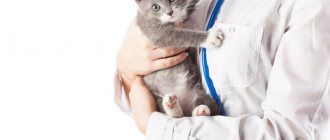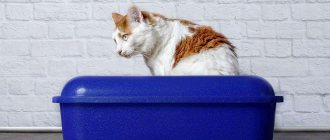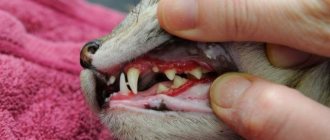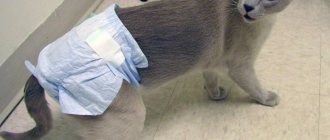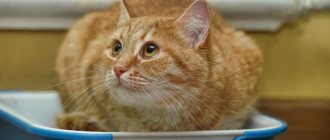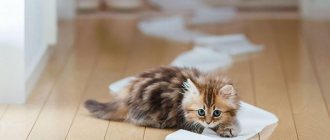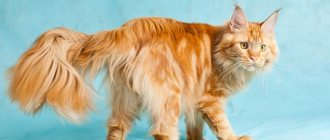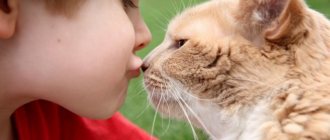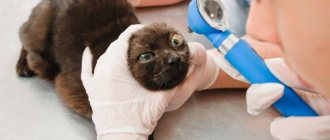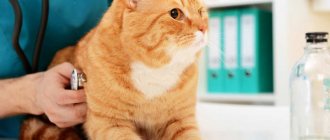The thick, beautiful fur coat of a domestic cat, no matter how long it is or what breed it belongs to, is a natural protection for both the thin cat’s skin and the cat’s entire body from uncomfortable environmental temperatures, pathogens, excessive humidity, and all kinds of traumatic factors.
And a fur coat shining with health is the pride of the owners. It is important that at any time of the year the animal’s coat is healthy, shiny and clean.
Cat fur is a mirror of health
Of course, most cats are very clean and are able to clean themselves. And thanks to their flexible spine, they do this great. But still, the kitty cannot do without the help of the owner.
What to do to make your cat have beautiful fur: 5 tips
Cats are clean and handsome. In nature, whiskers take care of their fur on their own, but at home you can help them look even more luxurious. We will give 5 tips on how to improve your cat's coat.
The appearance of a pet is a mirror of its health. If a cat has bad hair, the first thing to do is take the animal to the veterinarian. Dull hairs, too much and sudden shedding, and the appearance of bald spots can be symptoms of serious illnesses. And here you can’t get by with special food, vitamins or bathing.
1. Adjust your cat's diet
A balanced diet will 99% help improve your cat's coat. If you feed your animal natural food, be sure to discuss the menu with your veterinarian. He will tell you which products to add and which to exclude.
If you feed your cat with industrial food, choose a good cat food to improve its coat. This can be a complete GO cat food. It is suitable for both adult animals with different activity levels and kittens.
2. Sow grass for the cat
Set aside a place on the windowsill for a small tray of wheat germ, oats, or a special collection of “Grass for Cats” (sold in pet stores and seed stores). Such an addition to the diet will not immediately improve the cat’s fur, but the “apartment” resident will definitely like it and will affect her appearance over time.
Greens will help remove hairballs from the stomach easily. This will help avoid serious health problems (sometimes so much hair and undercoat accumulates in the stomach that surgery is required). Sprouted grass is especially relevant in the cat’s menu during periods of shedding.
3. Brush your cat regularly
What can you do to make your cat have beautiful fur? Brush it regularly. Buy a good comb/brush that matches the length of the hair and the size of the animal. Train yourself and your pet to brush at least every other day. A furminator is also a special “comb” that effectively removes dead hairs from the undercoat. It is enough to use it once a week, during the molting period - 2 times.
The cat has bad fur. What to do? Perhaps this is a seasonal molt and you just need to get through it.
Brushing does more than just improve your cat's coat. This is a simple and enjoyable procedure for most furry pets:
- prevents the formation of tangles. Mats often appear in long-haired breeds with abundant undercoat; removing them is not always a pleasant procedure for the animal. Therefore, it is better to prevent tangles than to cut them later;
- reduces the amount of scattered hair on furniture, floors, clothes, as dead hairs are removed with a comb;
- prevents the stomach from becoming clogged with hairballs. Yes, it is impossible to remove all the dead hair from a cat, but it is possible to reduce what it eats with each wash.
4. Keep your skin healthy
Another recommendation on what to do to ensure your cat has beautiful fur is to monitor the health of its skin. Regularly inspect your body for ringworms, sores, lesions, ticks, lice and fleas. Yes, yes, even those cats who never leave the threshold of the apartment periodically develop skin parasites. Lice and fleas can easily be brought in on your clothes, shoes, or with any items from the street. Moreover, they are completely independent and will cross the threshold of the apartment, and then end up in the cat’s fur.
Be sure to give your cat anthelmintic medications once every 3 months - for prevention. Sometimes, in order for a cat to have beautiful fur, it is enough to get rid of parasites.
5. Stop bathing your cat often
If a cat has bad fur, it is not enough to know what to do. You need to determine what not to do. For example, do not bathe your cat more than once a year. Why?
- firstly, it is stress, both for the animal and for you. And stress is bad for everyone;
- secondly, you wash away the natural protective layer from the fur and skin.
Fluffy takes care of his hygiene on his own. You cannot do without bath procedures in several cases:
- doctor's recommendation (skin diseases, presence of parasites, etc.);
- very dirty cat. For example, if you just adopted a pet from the street.
If your pet has dirty its paws or other parts of its body, you should not bathe it all. It is enough to wash only the dirty part of the body.
There are medicated shampoos and special care products that can improve a cat's coat. Use them only after consulting a veterinarian or groomer.
What do you do to make your cat have beautiful fur? What cat food do you choose to improve their fur? Share your tips in the comments!
Features and symptoms of the disease
High greasiness of the coat is a disease that most often affects unneutered cats. True, it can also appear in pets that have been castrated, but much less frequently. The main cause of oily fur on a cat's back, tail, or other parts of a fluffy's body is a pathology called perianal gland hyperplasia. Sebaceous secretions accumulate on the skin in excess. From there it gets onto the animal's fur, severely polluting it.
The symptoms of greasy coat syndrome are as follows::
- Oily hair appears at the base of the cat's tail, back or sides;
- the pet’s “fur coat” becomes dull and sticks together into tangles;
- on the pet’s skin a wax-like composition that has a brownish color and exudes a rancid odor;
- the skin in those areas where there is greasy hair becomes inflamed and red;
- often weakened and matted hair falls out;
- Scabs appear on the surface of the skin;
- the hair follicles become inflamed, and then many small pimples appear in their place.
© shutterstock
If the disease becomes chronic, the area of the body with damaged hair may become completely bald. The appearance of scabs on the skin leads to the unfortunate cat developing eczema.
Beautiful fur in cats: how to achieve
A fluffy cat, shining with health, is the pride of any owner. But what can you do to ensure that your fur is always attractive? We'll talk about this in our article.
3 main factors for a beautiful cat appearance:
- proper and regular care,
- balanced diet,
- suitable microclimate in the house.
In order for your pet to have a healthy coat and well-groomed appearance, you need to follow all the rules.
Content
Diagnostic measures
Only a veterinarian can accurately answer the question of why the cat’s fur has become fat and what to do to restore it to its former beauty and healthy shine. Diagnosis of a suspected disease involves a preventive examination by a veterinarian. During this procedure, a specialist examines the pet and, if necessary, recommends passing appropriate tests. If, in addition to greasy fur, the cat's skin is flaky and itchy, or dandruff appears, he should also be shown to a dermatologist.
Proper nutrition
The appearance and well-being of a cat largely depend on nutrition. If the diet is unbalanced, then this usually affects the quality of the coat: it becomes dry, loses its shine and elasticity, and hair begins to split and fall out. To avoid this, choose a complete ready-made food for your cat - it already contains all the necessary nutrients, vitamins, and minerals. Long-haired cats may also need a product to help remove hair from the gastrointestinal tract. A veterinarian will help you decide on the choice of diet and supplements, taking into account the cat’s breed, age, activity, and health status.
Remember that the animal’s diet should not include food from your table. If you want to cook for your pet yourself, study in advance the daily intake of calories, fats, proteins, carbohydrates, vitamins, micro- and macroelements that the cat should receive, and pay attention to prohibited foods. Among them are fish, poultry and meat bones, sweets, herbs, avocados, smoked meats, etc. For smooth coat and healthy skin, it is important to choose foods rich in B vitamins (beef liver, meat, dairy products, etc.), vitamin A ( egg yolks, sea fish liver, etc.), omega-3 and omega-6 fatty acids (salmon, eggs, etc.).
Causes of deterioration in wool quality
Negative changes in the coat include: hair loss, lack of shine, dryness/excessive oiliness, increased tendency to form tangles. Often the problems are a consequence of the “home” lifestyle:
- incorrect temperature conditions - this factor affects the metabolism and thermoregulation of the pet, making molting almost continuous, and new fur weak and sparse;
- nutrition – we are talking about an incorrect balance of proteins/fats/carbohydrates, vitamins/minerals. Also, the composition of the diet sometimes does not take into account features associated with the age and hormonal levels of the animal;
- stress – the cat may be disturbed by the appearance of another pet, noise, incorrect “bath” or grooming procedures;
- care – too frequent bathing, poor-quality cosmetics, insufficient/excessive combing;
- low physical activity and lack of fresh air - this also affects metabolism and the state of the immune system.
Conditional pathological reasons for changes in wool quality include:
- allergies - reactions to new foods or treats, food from the table, as well as medications or cosmetics;
- weakened state of the body - in kittens or older animals, during pregnancy/lactation or recovery from serious illnesses.
Among the diseases accompanied by deterioration of hair:
- enlargement/inflammation of the sebaceous glands – provokes excess sebum production and hair loss;
- parasitic and fungal infestations – fleas, lice, micromites, ringworm;
- dermatitis of various nature;
- hereditary (in Persian and exotic cats) and secondary seborrhea;
- hormonal disorders - thyroid disease, diabetes, disruptions due to sterilization or taking corticosteroids;
- diseases of the gastrointestinal tract, liver and kidneys;
- helminthiases;
- infectious and viral diseases;
- dental problems.
Indoor microclimate
Is there a lot of yellow light bulbs in the house, is the air dry? In this case, the cat's fur may become dry and lifeless. For the health and beauty of your pet, pay attention to the microclimate in the house. Various ways can help improve it:
- frequent wet cleaning without the use of chemicals;
- regular ventilation of rooms;
- reducing heating intensity. If this is not possible, make sure that the cat does not sleep on the radiators. Equip her with a cozy house or bed;
- using a humidifier.
If you think you're doing everything right, but your cat's appearance still isn't up to par, visit your veterinarian. Coat problems can be symptoms of various diseases. Also, do not forget about routine medical examination, vaccination, and deworming of your pet. All this can help your cat be healthy for many years and delight you with its beauty and playfulness.
Sources:
https://allexpert.com.ua/chto-delat-chtoby-u-koshki-byla-krasivaya/ https://www.ikirov.ru/news/32833-8-sposobov-privesti-sherst-koshki-v- poryadok https://www.vetmag.ru/advice/koshki-uhod-za-sherstyu/kak-dobitsya-krasivoj-shersti-u-koshek/
Diagnosis and treatment
If hair comes off the tail, your four-legged pet should be taken to the vet immediately. At home, without laboratory instruments and professional skills, it is impossible to make an accurate diagnosis and develop a recovery program.
At the veterinary clinic, specialists interview the animal’s owner, study the history of diseases, take a blood test and organize a special study to identify hormonal imbalances. A scraping and ultrasound are performed, which helps determine why the fur is peeling off and whether there are critical disorders in the body.
Treatment methods include the following:
© shutterstock
Bathing
By licking itself, the cat cleans its fur of debris and dust, but dead skin particles remain on it - they will have to be washed off, regardless of the animal’s dissatisfaction.
Before bathing, we recommend trimming your cat’s nails and combing out tangles. Remember that your cat should only be washed with special shampoo from a pet store or veterinary pharmacy, as human shampoos can cause itching in the animal. It is better to bathe a cat together: one person should carefully hold the animal, and the second should soap it.
It is important to ensure that water does not get into your ears or nose. The muzzle cannot be washed with water - it is wiped with a damp sponge. You need to rinse the shampoo thoroughly until the water runs clear. It is especially important to monitor this if the cat belongs to a long-haired breed. But it is not necessary to dry your pet dry; just blot it with a towel to moderate humidity. However, if the cat is not afraid of a hair dryer, then you can use it.
Cosmetics against dull fur
Grooming, which includes brushing, massage, trimming, removing tangles and bathing, is of no small importance. During the procedures, dead undercoat and weak hairs are removed, the skin is massaged, which stimulates blood flow to the upper layers of the epidermis. Properly selected shampoos, conditioners and nourishing masks will help restore abundant hair growth and its structure, and ensure skin hydration and regeneration. The cosmetic treatment for a cat's fur includes the following steps:
- bathing, aimed at cleansing from impurities, giving the coat shine and a more pronounced color;
- conditioning to make combing easier;
- haircut or hair correction.
If the dulling of the coat is not caused by internal problems, then tinted shampoos from the Royal Groom series will help to refresh the natural shade and give a healthy shine and silkiness. Cosmetics contain only natural color enhancers and biologically active components that help restore hair structure: provitamin B5, olive oil, aloe vera extract. For animals with light-colored hair, “White Cloud” shampoo is suitable; the red and chocolate shade will sparkle with new facets after using the “Golden Fleece” detergent. Black Pearl shampoo will help highlight the nuances of dark-colored fur.
When used regularly, tint products revitalize the coat color, adding contrast and shine and highlighting the natural beauty of the natural color.
Source
Causes of food allergies
There are several mechanisms for the development of allergies. But a significant proportion of cases are associated with type 1 hypersensitivity. It is explained by the release of immunoglobulin IgE and the activation of basophils. This reaction occurs in response to the entry into the digestive system of protein compounds recognized by immune cells.
Some predisposing factors are unique to children, others are also found in adults. Among the most common reasons are the following:
- Features of allergens in food. The reaction is most often provoked by antigens with high immunogenicity. They easily overcome the aggressive environment of the stomach. They are found in large quantities in whole milk, fish, eggs, cereals, strawberries, citrus fruits, and nuts.
- Hereditary predisposition. Food allergies are associated with hereditary characteristics of the body. They manifest themselves by increased reactivity, disruptions in the functioning of the immune system, as well as other mechanisms.
- Age-related features of the development of the digestive system. Children have high permeability of the stomach walls, and the acidity of gastric juice is lower than in adults. The composition of the microflora is also different. All this creates favorable conditions for the allergen to come into contact with immune cells.
The condition may be associated with the amount of food eaten and the characteristics of culinary processing. There are cases of so-called cross-allergy to pollen and household dust: some food products with similar compounds in their composition trigger an allergic reaction.
According to many researchers, the formation of allergies is facilitated by dietary violations during pregnancy, as well as early transfer of the child to artificial feeding. Gastrointestinal diseases, especially diseases of the liver, gallbladder, and biliary tract, also trigger and contribute to the exacerbation of allergies.
Make sure there are no tangles or matted fur.
The presence of tangled hair and tangles causes constant discomfort to the cat, and therefore affects its well-being and overall health. Tangles are an environment for the development of various kinds of pathogenic bacteria, because they are warm and moisture regularly gets there.
In addition, tangles constantly pull the skin with their weight. Therefore, very often, under the removed mat, you can find inflamed skin.
Some breeds of cats have difficulty keeping their coats clean and mat-free because their fur is too long and soft. The cat is physically unable to put it in order. In this case, you should help her.
Teach her to put up with daily procedures: alternate brushing with giving treats, and, of course, be very careful, because cats have very sensitive and thin skin.
If your cat is already matted, you should probably contact a professional groomer. Although daily procedures using, for example, a special combing glove are much better, cheaper and easier for the cat to tolerate.
Foods and additives that cause allergies
Doctors Sidorovich and Luss write that “almost any food product can act as an allergen and cause the development of food allergies. However, the most pronounced sensitizing properties are in products of protein origin containing animal and plant proteins” (Sidorovich O.I., Luss L.V., 2016, p. 141). The table shows the most common allergens in food:
| Plant food | Raspberries, strawberries, wild strawberries, black currants, blackberries, pineapple, melon, persimmon, pomegranate, citrus fruits, chocolate, tomatoes, nuts, honey, mushrooms, wheat, soybeans, carrots |
| Animal food | Milk, eggs, fish, crustaceans and seafood, cold processed chicken |
| Supplements | Pesticide residues and agricultural fertilizers in plant foods. Dyes (especially tartrazine, erythrosine, sodium nitrite), flavorings (glutamates), preservatives (benzoates, benzoic acid, sulfites), enzymes, thickeners, emulsifiers, bacteriostatics, flavor enhancers (monosodium glutamate), etc. |
Note that allergen additives provoke so-called false reactions, or pseudo-allergies. In this case, food antigens can act without the participation of allergic antibodies on target cells or activate certain biological systems; they are not based on immune reactions.
An increase in the level of histamine in the blood may not be associated with a true allergy, but with the consumption of foods containing it in large quantities: fermented cheeses, sauerkraut, dried ham, canned food, spinach.
What does symmetrical alopecia in cats indicate?
Symmetrical alopecia in cats is formed by intense licking of parts of the body on both sides, resulting in the formation of symmetrical bare areas of skin, but in which the remains of broken hairs can be seen. Most often, the cause of symmetrical baldness is itchy skin, less often - nervous disorders or stress.
The following reasons can cause symmetrical baldness:
- allergies to food or other products;
- disruption of the development of hair follicles associated with the color of the animal;
- diseases and tumors of the pancreas, etc.
